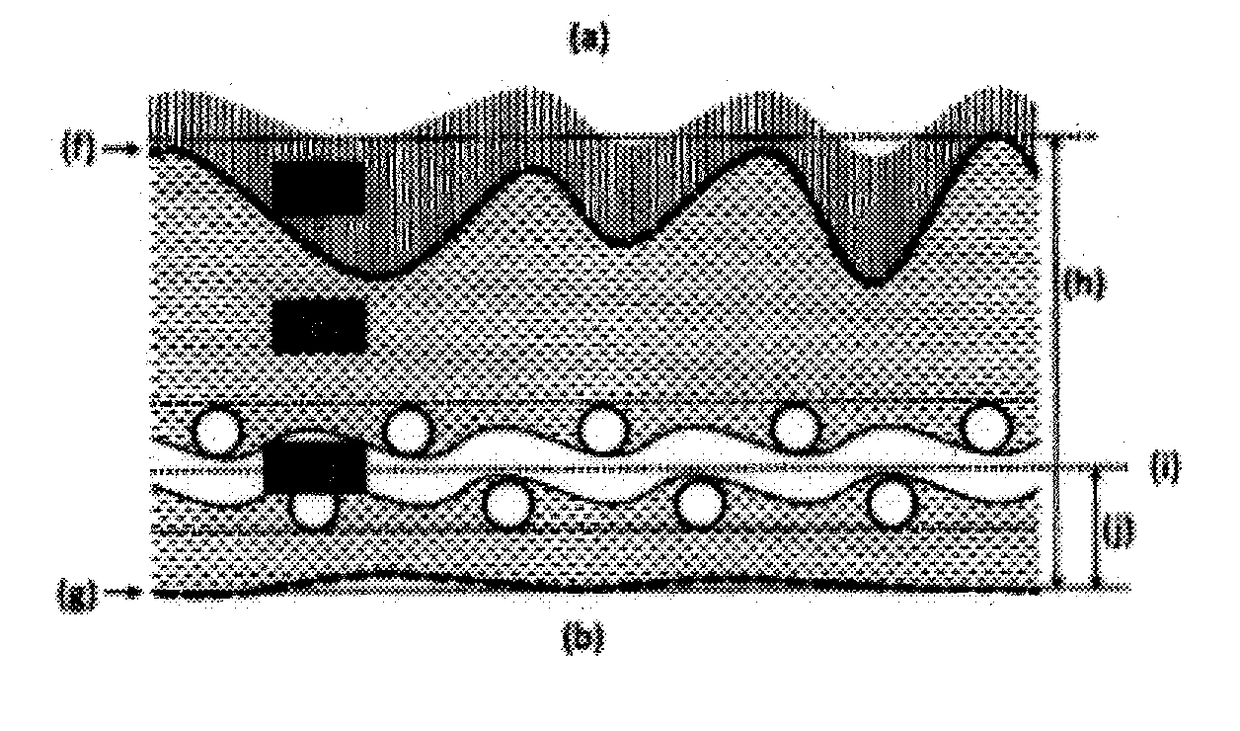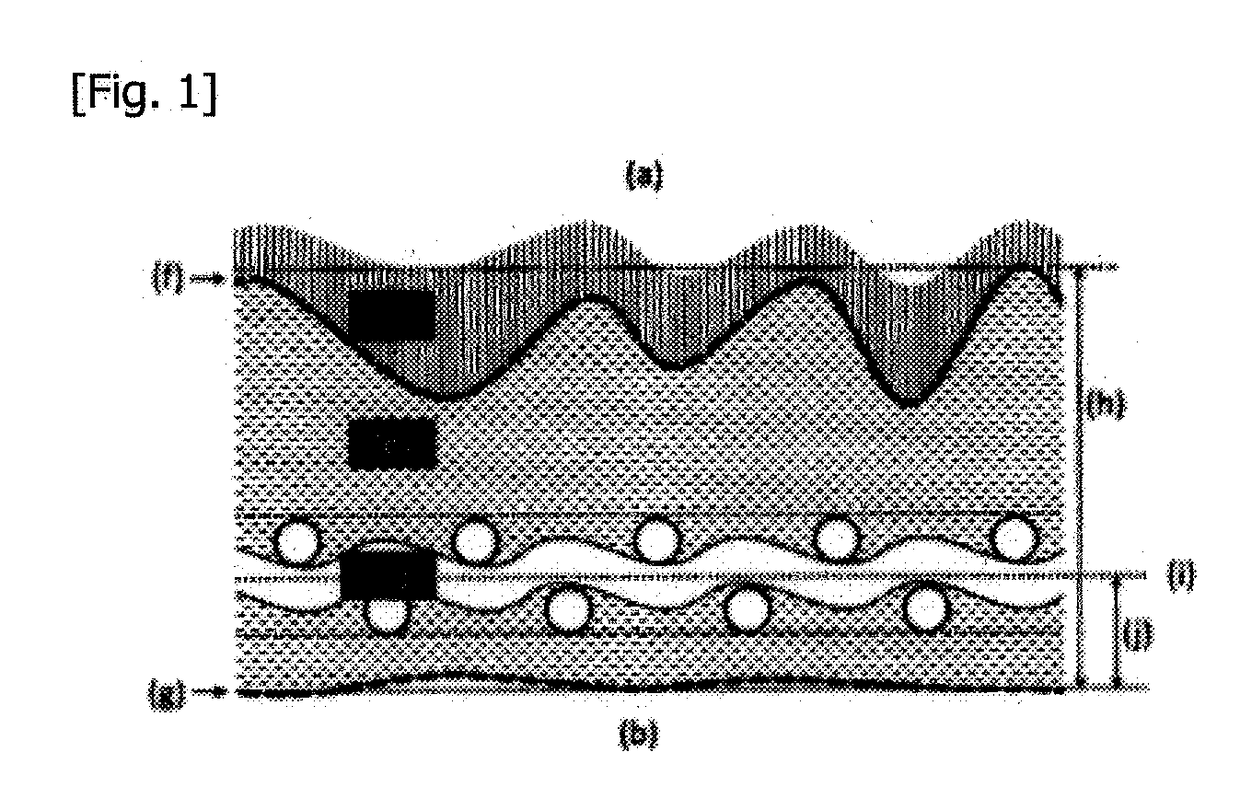Artificial leather and a production method therefor
a production method and technology of artificial leather, applied in the field of artificial leather, can solve the problems of color tone difference between ultrafine fibers and artificial leather provided with a high density feel, and achieve the effect of low color inconsistency and high density napping
- Summary
- Abstract
- Description
- Claims
- Application Information
AI Technical Summary
Benefits of technology
Problems solved by technology
Method used
Image
Examples
example 1
[0126]Polyethylene terephthalate used as island component and polystyrene used as sea component were melt-spun through a spinneret designed for 16-island sea-island type composite fiber with an island / sea mass ratio of 55 / 45, followed by stretching, crimping, and subsequent cutting to a 51 mm length to prepare raw stock of sea-island type composite fiber with a monofilament fineness of 4.3 dtex.
[0127]The above raw stock of sea-island type composite fiber was processed by carding and crosslapping to provide a laminated web, which was then needle-punched at a punching rate of 100 punches / cm2 so that the woven fabric would not suffer from creasing due to rapid changes in width when attaching a woven fabric. Elsewhere, a multifilament (84 dtex, 72 filaments) with a twist count of 2,500 T / m composed of monocomponent filaments with an intrinsic viscosity (IV) of 0.65 was used as weft while a multifilament (84 dtex, 72 filaments) with a twist count of 2,500 T / m composed of monocomponent fi...
example 2
[0132]Except that the monofilament fineness was 2.9 dtex, the same procedure as in Example 1 was carried out to produce raw stock of sea-island type composite fiber.
[0133]Except that the metsuke was 705 g / m2 and that the thickness was 3.0 mm, the same procedure as in Example 1 was carried out to produce a laminated sheet of an entangled fiber mass of sea-island type composite fiber and a woven or knitted fabric and.
[0134]Except that the degree of grinding was controlled to adjust the thickness to 0.7 mm and that the shrinkage rate in the dyeing step was 19%, the same procedure as in Example 1 was carried out to produce artificial leather. For the artificial leather thus obtained, the arithmetic average height, Pa, of the cross-sectional profile curve of the napped surface was 28 μm; the arithmetic average height of the cross-sectional profile curve of the other surface (Surface B) was 56% of the Pa value of the napped surface; and 3.5 asperity peaks forming irregularities of the cro...
example 3
[0136]Except that a 36-island spinneret for sea-island type composite fiber production was used and that the monofilament fineness was 3.1 dtex, the same procedure as in Example 1 was carried out to produce raw stock of sea-island type composite fiber.
[0137]Except for adopting a plain weave fabric having a weaving density of 69 warp yarns per 2.54 cm and 84 weft yarns per 2.54 cm, a dry heat area shrinkage rate of 2% after dry heat treatment at a temperature of 100° C. for 5 minutes, and a dry heat area shrinkage rate of 20% after dry heat treatment at a temperature of 140° C. for 5 minutes, that was produced by using, as weft, a multifilament (56 dtex, 12 filaments) with a twist count of 1,500 T / m composed of side-by-side type filaments of polyethylene terephthalate with an intrinsic viscosity (IV) of 0.78 and polyethylene terephthalate with an intrinsic viscosity (IV) of 0.51 and using, as warp, a multifilament (84 dtex, 72 filaments) with a twist count of 2,500 T / m composed of mo...
PUM
| Property | Measurement | Unit |
|---|---|---|
| arithmetic average height | aaaaa | aaaaa |
| arithmetic average height | aaaaa | aaaaa |
| residual elongation rate | aaaaa | aaaaa |
Abstract
Description
Claims
Application Information
 Login to View More
Login to View More - Generate Ideas
- Intellectual Property
- Life Sciences
- Materials
- Tech Scout
- Unparalleled Data Quality
- Higher Quality Content
- 60% Fewer Hallucinations
Browse by: Latest US Patents, China's latest patents, Technical Efficacy Thesaurus, Application Domain, Technology Topic, Popular Technical Reports.
© 2025 PatSnap. All rights reserved.Legal|Privacy policy|Modern Slavery Act Transparency Statement|Sitemap|About US| Contact US: help@patsnap.com



